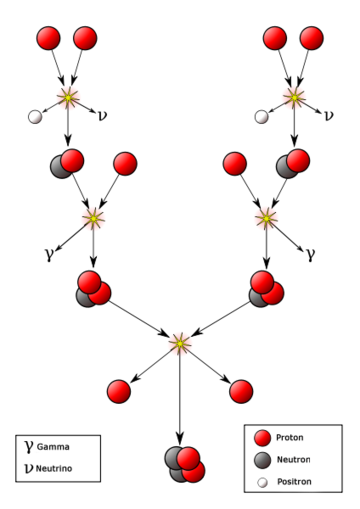Nuclear fusion in the Sun

The energy from the Sun - both heat and light energy - originates from a nuclear fusion process that is occurring inside the core of the Sun. The specific type of fusion that occurs inside of the Sun is known as proton-proton fusion.[2]
Inside the Sun, this process begins with protons (which is simply a lone hydrogen nucleus) and through a series of steps, these protons fuse together and are turned into helium. This fusion process occurs inside the core of the Sun, and the transformation results in a release of energy that keeps the sun hot. The resulting energy is radiated out from the core of the Sun and moves across the solar system.[3] It is important to note that the core is the only part of the Sun that produces any significant amount of heat through fusion (it contributes about 99%).[3] The rest of the Sun is heated by energy transferred outward from the core.
Steps
The overall process of proton-proton fusion within the Sun can be broken down into several simple steps. A visual representation of this process is shown in Figure 1. The steps are:[4]
- Two protons within the Sun fuse. Most of the time the pair breaks apart again, but sometimes one of the protons transforms into a neutron via the weak nuclear force. Along with the transformation into a neutron, a positron and neutrino are formed. This resulting proton-neutron pair that forms sometimes is known as deuterium.
- A third proton collides with the formed deuterium. This collision results in the formation of a helium-3 nucleus and a gamma ray. These gamma rays work their way out from the core of the Sun and are released as sunlight.
- Two helium-3 nuclei collide, creating a helium-4 nucleus plus two extra protons that escape as two hydrogen. Technically, a beryllium-6 nuclei forms first but is unstable and thus disintegrates into the helium-4 nucleus.
The final helium-4 atom has less mass than the original 4 protons that came together (see E=mc2). Because of this, their combination results in an excess of energy being released in the form of heat and light that exits the Sun, given by the mass-energy equivalence. To exit the Sun, this energy must travel through many layers to the photosphere before it can actually emerge into space as sunlight. Since this proton-proton chain happens frequently - 9.2 x 1037 times per second - there is a significant release of energy.[3] Of all of the mass that undergoes this fusion process, only about 0.7% of it is turned into energy. Although this seems like a small amount of mass, this is equal to 4.26 million metric tonnes of matter being converted to energy per second.[3] Using the mass-energy equivalence, we find that this 4.26 million metric tonnes of matter is equal to about 3.8 x 1026 joules of energy released per second!
For Further Reading
For more information on the energy that comes from the Sun, see:
- Sun
- Solar radiation
- Insolation
- Solar energy to the Earth
- Temperature of the Earth
- Solar power
- Or explore a random page
References
- ↑ Wikimedia Commons. (July 30, 2015). Fusion in the Sun [Online]. Available:https://upload.wikimedia.org/wikipedia/commons/0/03/Fusion_in_the_Sun_it.png
- ↑ Fraser Cain. (July 30, 2015). Fusion in the Sun [Online]. Available: http://www.universetoday.com/18707/fusion-in-the-sun/
- ↑ 3.0 3.1 3.2 3.3 Jerry Coffey. (July 31, 2015). How Does The Sun Produce Energy? [Online]. Available: http://www.universetoday.com/75803/how-does-the-sun-produce-energy/
- ↑ Karl Tate. (July 30, 2015). Proton Fusion, the Sun's Power Source, Explained [Online]. Available: http://www.space.com/26956-proton-fusion-sun-power-source-infographic.html

